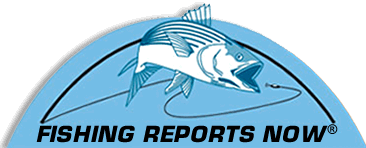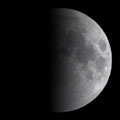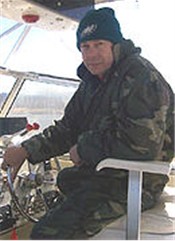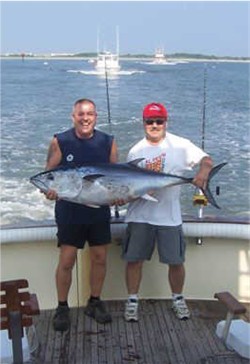| Why Take Your Lumps? Fish the Inshore Lumps By Mark Marquez II Based on an interview with Capt. Stan Staniewicz, Canyon Clipper Charters, Cape May |
||
|
The Hambone. The Hot Dog. The Chickenbone. In summer these silly names for hills in the ocean start filling the fishing reports. Bluefin tuna have arrived at the inshore lumps. Numerous such lumps and small canyons fill the waters in 20 to 30 fathoms between 25 and 50 miles offshore. Like any fish, bluefins are attracted to bottom rises and dips. Capt. Stan Stankiewicz of the Canyon Clipper, a Cape May charter boat, targets these tuna. Some of the runs to the grounds are as short as a half-hour from Cape May, such as the trip to the East Lump, less than 25 miles east of the inlet. Other trips are more than twice as long, such as a 1-1/2-hour sail to the Elephant Trunk, about 50 miles southeast of Cape May. The time it takes to make the runs also depends on seas and the weather. The bluefins show up in June or July and can swim these waters through September. The best fishing usually occurs from July to September. The fish weigh 30 to 150 pounds or more. Smaller ones arrive first, and bigger ones show up toward mid July. At first the tuna only hit on the troll. But sometime in July they start hitting on dead bait, live bait or jigs while chunks of bait are tossed in the water for chum. Stan usually likes to chunk in the mornings and then go on the troll on the way home later in the day. He prefers to be chunking by dawn, because chunking seems best at first light. |
|
bottom to suspended close to the top. One might be placed 10 feet from the bottom, and another 50 feet down, with another fised 20 feet down. One is flatlined close to the surface. Styrofoam floats are used, except on the flatline. Stan prefers how the Styrofoam breaks in half and falls away when a fish is fought. The leader should be 30- to 60-pound test, and the light line makes a difference, because these fish do become leader shy. The later in the season, the more leader shy they can become, and the fishing becomes a trick of how light a leader can be used without breaking off the fish. Fluorocarbon helps make the leader invisible. If you know anything about tuna fishing, you know that these fish hit like a freight train that doesn’t plan on stopping at the next station. Stan prefers chunks of butterfish for bait, because tuna like the flashy skin. Sardines or other bait can be used, and so can live bait, such as spots, that can be brought on the trip. Adult bunker are usually the only bait that swims the surface of these waters that can be livelined, and Stan avoids the bunker, because the skin is dull, unlike the butterfish. The flash is also a reason that tuna like diamond jigs. Jigging is a topic in itself that could be covered in a whole other article. When the sun rises too much, the fish often stop biting on the chunk, but not always. After chunking in the morning, trolling can produce a bonus on Stan's trips: other fish in addition to tuna, including mahi mahi, wahoo, skipjacks and false albacore. Stan likes to troll cedar plugs, Clark spoons, birds with Green Machines and ballyhoos. He chooses a spot to fish either based on a temperature break, preferably around 72 to 73 degrees, or on the edge of structure or crevices or cracks. But either a temp break or structure is necessary. Bluefin tuna are big, put up a tremendous fight, are challenging to catch and are very tasty. Tuna can be caught farther offshore, but one of the main attractions about this fishery is the short ride. Treat yourself. While these fish are closer to shore, you can avoid the tiring, 100-mile run for tuna to the continental shelf for a change. Why take your lumps? Fish the inshore lumps! |
||







